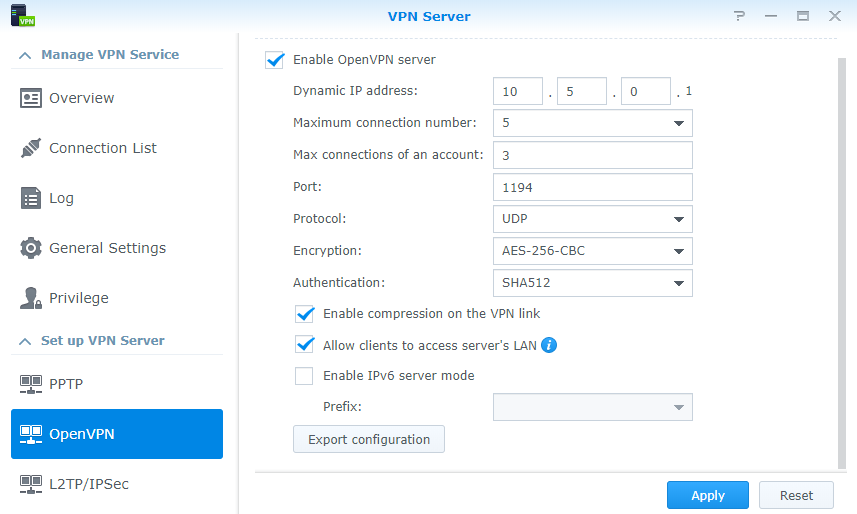

- #Where are openvpn access server config file install
- #Where are openvpn access server config file password
- #Where are openvpn access server config file windows
For help with trouble shooting connection problems please see HOWTO: Request Help !. The first thing to do is examine your log file for details of the errors encountered. #Where are openvpn access server config file windows
If silent-connection is enabled and the username/password are saved then the dialog is not shown.Įditing the Windows Registry is strongly discouraged. Otherwise it's auto-submitted after the 6 seconds timeout. If during that time the user clicks on the window, the timeout is cancelled and the dialog stays on the screen until manually submitted. The way it works is like this: if username/password is available, the dialog window is prefilled and displayed for 6 seconds.
The "enter user/pass timeout" can not be configured. These settings are saved in the Windows Registry under : HKCU\Software\OpenVPN-GUI. #Where are openvpn access server config file password
You can choose to save the password but the username is always saved.Your client.ovpn file must contain the -auth-user-pass directive.If your server requires a username and password you will see this dialogue box. You now have access to your configuration file.ĭo not edit your client configuration file unless you know what you are doing!.A good application for editing configuration files is Notepad++.You now have access to your VPN log file.
 A good application for viewing your log file is BareTail. You now understand the OpenVPN-GUI menus. With two or more configuration files the menus will be nested. The Main menu with 2 configuration files imported: With only one configuration file the menu displays all actions directly. The Main menu with only 1 configuration file imported: If you are logged in to your desktop with an Administrator account then this stage will be omitted. THIS STAGE MUST BE COMPLETED BY YOUR COMPUTER ADMINISTRATOR You must now be a member of the Openvpn Administrators group. Message dialogue Require membership in OpenVPN Administrators group If you do not have this password then please contact your network administrator for help. If you see the message below you can select Yes but you will need the Local Administrator password to continue.
A good application for viewing your log file is BareTail. You now understand the OpenVPN-GUI menus. With two or more configuration files the menus will be nested. The Main menu with 2 configuration files imported: With only one configuration file the menu displays all actions directly. The Main menu with only 1 configuration file imported: If you are logged in to your desktop with an Administrator account then this stage will be omitted. THIS STAGE MUST BE COMPLETED BY YOUR COMPUTER ADMINISTRATOR You must now be a member of the Openvpn Administrators group. Message dialogue Require membership in OpenVPN Administrators group If you do not have this password then please contact your network administrator for help. If you see the message below you can select Yes but you will need the Local Administrator password to continue. #Where are openvpn access server config file install
This is normally done during the install phase but it may not have been done. In order for your normal user to be able to use openvpn, your user account must be added to the OpenVPN Administrators group on your computer. Setting up membership of the OpenVPN Administrators local group You should now have a successfully imported configuration file.

If you do not know what to do then please contact your server's administrator for help. Otherwise, check that you selected a correctly configured *.ovpn file. If your server administrator has provided a URL, username and password for importing from the server, use "Import->Import from URL." or "Import->Import from Access Server." and complete the dialog that opens up. If the import is successful you will see: " from the menu, then select the config.ovpn file you wish to import: Importing your first connection profile (config file) into the OpenVPN-GUI
\Program Files\OpenVPN\config ( \Program Files is the default installation directory)Īll *.ovpn files in these locations, including sub-directories, must have unique names. OpenVPN-GUI searches the entire directory tree (including sub-directories) of the following locations:. Press OK - All config files must have unique names. Message dialogue There already exists a config file named. You should now have a configuration file to import. If you already have a client configuration file to a VPN then now is the time to import it. If you are creating your own VPN server and client then please go here Press OK - You must have a configuration file to continue. Message dialogue No readable connection profiles found Preparing your installation to use the OpenVPN-GUI successfully You should now have access to the OpenVPN-GUI. You may use a desktop icon or the Windows menu to locate the OpenVPN-GUI. If you still cannot find the OpenVPN-GUI then make sure you opened it in the first place. (Because Windows likes to hide things from you. If you cannot find the OpenVPN-GUI icon then check that Windows has not hidden it from you. Setting up membership of the OpenVPN Administrators local group. Importing your first connection profile (config file) into the OpenVPN-GUI. Preparing your installation to use the OpenVPN-GUI successfully.







 0 kommentar(er)
0 kommentar(er)
